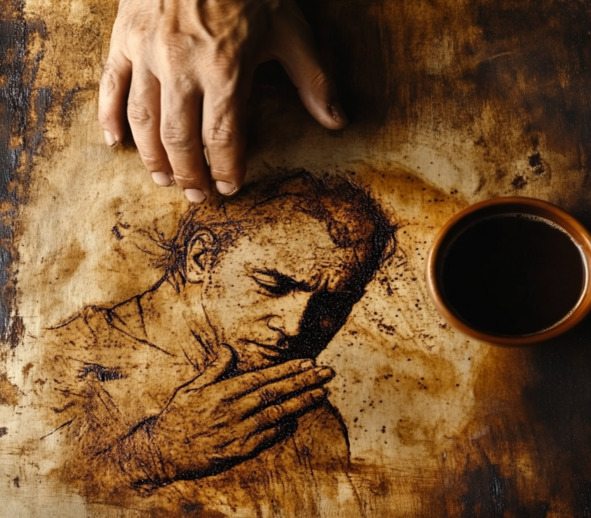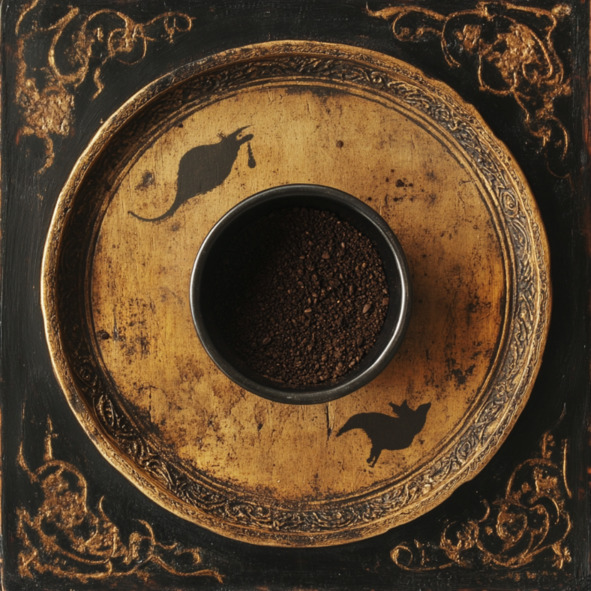
Полная версия
Fortune Telling on Coffee Grounds. A Self-help Guide for Everyone

Fortune Telling on Coffee Grounds
A Self-help Guide for Everyone
Emma Koh
© Emma Koh, 2025
ISBN 978-5-0064-7898-5
Создано в интеллектуальной издательской системе Ridero
TABLE OF CONTENTS
Section 1. History and principles of fortune telling on coffee grounds
Section 2. How to correctly read coffee grounds
Section 3. Basic steps of fortune telling on coffee grounds and interpretation
Lesson 1: Basics of tasseography or fortune telling on coffee grounds
Lesson 2: Preparing tools and space
Lesson 3: The fortune telling process: the technique of pouring and turning the cup
Lesson 4: Interpretation of symbols
1. Animals
2. Objects
3. Nature
4. Figures and symbols combinations
5. Letters and numbers
6. Spells and prayers in fortune telling on coffee grounds

Chapter 1. Traditions of fortune telling on coffee grounds
Coffee grounds divination, also known as tasseography, is an ancient practice that has been used by various cultures for centuries to predict the future and understand hidden knowledge. This
method of divination has a rich history and cultural values that vary from country to country. The history of ha Denmark on coffee grounds begins in the regions where coffee has become a popular drink. It is believed that the first practices of tasseography appeared in the Middle East in the XV century, shortly after coffee began to be cultivated and consumed in everyday life. Coffee houses, which spread to the cities of the Ottoman Empire, became places of social interaction, where fortune-telling on coffee grounds turned into a popular entertainment.
Tasseography is treated differently in different countries. For example, in Turkey, the grounds are turned over in a cup so that it leaves an imprint on the side wall and bottom of the cup, which is interpreted by a fortune teller. In Greece and Cyprus, fortune telling is also very popular, and there it is used to predict the future on a personal level, often on New Year’s Eve or at other significant moments. Not everyone knows that tasseography is not only the art of interpreting symbols, but also a psychological game. The fortune-teller uses his intuitive and psychological skills to interpret patterns, which makes fortune-telling look like reading artistic images, each time unique. One of the unexpected aspects of fortune telling on coffee grounds is its influence on contemporary art and culture. For example, in some modern art projects, images and symbols inspired by fortune-telling on coffee grounds are used, creating works that explore boundaries between chance and premeditation in art. Symbols appearing in coffee grounds can range from simple shapes such as hearts or circles to complex images such as animals or faces. The interpretation of these symbols depends on the cultural and personal attitudes of the gambler and the one who applies for the prediction. For example, meeting a fish image in a cup may mean an upcoming trip or new opportunities in Turkey, while As in some Western cultures, it can symbolize abundance or financial success. Tasseography also reflects cultural differences in approaches to time and fate. For example, in Western cultures, coffee grounds are often seen as a funny and frivolous practice, whereas in the Middle East and Eastern Europe it is treated with great respect and seriousness, considering it an important element of spiritual life and an important decision-making tool. In recent years, interest in fortune-telling has revived, partly due to the growing popularity of coffee as a cultural phenomenon. Cafes and private parties sometimes They include tasseography in the list of entertainment, offering visitors not only to enjoy the taste of coffee, but also to look into their future. This practice has adapted to modern life, sometimes being used for psychotherapeutic and entertainment purposes, which makes it accessible to a wide range of people. Tasseography as a form of divination is interesting because it reflects cultural differences in the perception of time and destiny, which are deeply rooted in the historical and social contexts of different peoples. These differences can be revealed in how people interpret the symbols found in coffee grounds, as well as in the questions they ask and the answers they expect to receive from divination.
In Middle Eastern countries such as Turkey or Iran, divination by coffee grounds is traditionally considered a serious matter. In these cultures, it is common to believe that a person’s destiny is predetermined, and divination can help to reveal its secrets. For this reason, tasseography sessions can be accompanied by rituals and prayers. It is also important to consider that in these cultures there is often a belief that time is cyclical and that the past, present and future are more closely linked than in the Western linear concept of time.
In Western countries, including Europe and North America, tasseography is often viewed as more lighthearted and entertaining. There is an emphasis on personal responsibility and freedom of choice, so tasseography is seen as more of a pastime than a serious way of predicting the future. Time is perceived as linear, and each person is expected to have influence on their own destiny, which is reflected in more open and meaningful interpretations of the symbols in the coffee grounds.
In East Asian countries, where tasseography is less traditional, such forms of divination may be adapted to take into account local views on karma and predestination. For example, in China and Japan, other forms of divination, such as the inching, are popular, which also rely on the interrelationship of the past, present, and future, and this concept may overlap with tasseography when it is adapted in these countries.
Differences in religious and philosophical beliefs also profoundly affect the practice of tasseography in different cultures. Religious teachings can either restrict or support the use of divination depending on their view of divination and free will. For example, in Islam, the practice of reading coffee grounds may face religious restrictions. Islam has traditionally been skeptical of divination, since predicting the future may be seen as an attempt to know something that only Allah knows. However, in many Muslim societies, reading coffee grounds continues to be a popular folk custom, performed in a more informal and entertaining manner. Views on divination may also vary within Christian communities. Some sects may find divination unacceptable, seeing it as a form of idolatry or superstition. At the same time, in Catholic and Orthodox cultures, including divination, exist that coexist with formal religious practice, especially in areas with strong traditional beliefs. In cultures where Eastern philosophies predominate, such as Buddhism or Taoism, ideas about fate and time may differ greatly. In these philosophies, time is often perceived as cyclical, and a person’s life is seen as a series of reincarnations, each providing opportunities for spiritual growth. Divination in such contexts may be viewed as a tool for meditation and self-knowledge rather than as a means of accurately predicting the future. Tasseography not only reflects philosophical and religious attitudes, but also serves an important social function. In many cultures, divination sessions serve as an occasion for gatherings and social meetings where participants can discuss personal and social issues. This creates a special atmosphere of community and support, where participants can share their hopes and fears in a protected, supportive environment. We can assert that Tasseography, as a form of teaching, is closely linked to cultural, religious and philosophical beliefs, which makes it not just a way of predicting the future, but also a mirror reflecting the views of society on the world and human destiny. Fortune telling on coffee grounds is often accompanied by various rituals, which may include special prayers, preparing the place, choosing the time for fortune telling, and even a specific way of serving and drinking. With the advancement of technology and changes in social attitudes, tasseography has also adapted to the modern world. For example, some online platforms now offer virtual coffee grounds reading sessions, where traditional methods are combined with new technologies to attract young people and people interested in new forms of spiritual practice.
Modern and Ancient Tasseography Practices, Their Differences and Similarities Tasseography, although having ancient roots, continues to evolve and adapt to modern conditions, taking on new forms and methods. At the same time, modern and traditional tasseography practices have both similarities and differences, each of which uniquely affects the cultural and individual meaning of this activity.
Similarities
Both traditional and modern coffee grounds reading methods are based on the interpretation of symbols and images that are seen in the remains of coffee. These symbols can be interpreted in a variety of ways, but the idea that they can provide insight into the future or understanding of current circumstances remains the same. Regardless of the context in which divination is performed, it is often accompanied by certain rituals. This may include a specific way of preparing coffee, the way the grounds are poured and distributed in the cup, and special prayers or meditations.
Differences
Modern practices increasingly use digital technologies. For example, there are smartphone apps that allow users to take a photo of their coffee grounds and get an automated interpretation of the symbols, but this alone does not give the full picture. A person must have special sensitivity traditional methods may have been more closed and carried out in a more intimate, ritual setting. In traditional societies, tasseography can have deep spiritual and cultural meanings, while in modern practitioners it is often devoid of religious context and is used as a means of personal entertainment or self-knowledge without cultural or spiritual heritage. Traditional methods of coffee ground reading often involve deep personalization in the interpretation process, taking into account the personal stories and circumstances of the client. In modern practice, especially in automated formats, interpretations can be more standardized and generalized.

Chapter 2. How to read coffee grounds correctly
Fortune telling on coffee grounds, or tasseography, is the art of interpreting patterns left by coffee sediment at the bottom of a cup. This process includes not only the act of divination itself, but also preparatory rituals, coffee selection, preparation and serving of a drink. Here is a detailed description of each stage:
Choosing a coffee
For tasseography, natural washed coffee of medium or fine grinding without additives and aromatizers is best suited so that the grounds are as readable as possible. It is recommended to use freshly roasted and freshly ground coffee, as it leaves pronounced patterns and has a strong fragrance that can enhance the atmosphere of the ritual.
Methods of preparation
The ideal way to prepare coffee for fortune telling is to boil it in a Turk over low heat. The water should heat up slowly, and add the coffee when the water is almost boiling. It is important that the coffee does not boil, as this can destroy the patterns formed by the grounds. After adding the coffee to the Turk, keep it on the fire until the foam rises, but do not let it boil away. After removing from the heat, the coffee should steep for a few minutes so that the grounds settle to the bottom.
Choice of dishes
Thick porcelain or ceramic cups are best, as they retain heat for a long time. The cup should be narrow at the base and widen towards the edges so that the patterns are clear and easy to interpret. It is advisable to use light-colored cups so that the patterns of the grounds are more noticeable.
Accompanying rituals
It is important that the entire process takes place in a calm and clean environment. Some practice meditation or prayer before the beginning of the fortune-telling to tune in to the perception of the symbols of the oxen. After the coffee is drunk, the cup is carefully placed on top with the saucer on top and turned upside down so that the grounds can flow down the sides of the cup, forming patterns. The cup should stand upside down for several minutes, usually five to ten, so that the grounds completely settle and form clear figures.
After the cup is turned back upside down, the fortuneteller begins the interpretation. The patterns formed by the grounds can be located on the bottom, sides or edges of the cup, each of which has its own meaning. The bottom of the cup refers to deeply personal or long-term issues, to the foundations of the questioner’s life. The sides of the cup show events that are happening in the present or will develop in the near future. The edge of the cup symbolizes immediate events or thoughts that are on the surface of the questioner’s consciousness. In modern practice, there is a more liberal approach to fortune-telling, where traditional methods are combined with new technologies and psychological methods. For example, there are online courses on tasseography and even applications that analyze photographs of coffee grounds for preliminary interpretation. These tools can serve as an introduction to fortune-telling for beginners or as an additional tool for more experienced practitioners. For example, animals usually symbolize people or events associated with animal characteristics (for example, a fox can mean cunning). And figures and objects can have literal or metaphorical meaning (for example, a ring often symbolizes a wedding or the completion of affairs). On the other hand, natural elements such as water or mountains can indicate an emotional state or obstacles, respectively. However, we will dwell on the issue of interpreting coffee grounds in maximum detail a little later, in section number three of our book.
Coffee ground reading continues to attract attention not only as a traditional art form, but also as part of a modern culture of self-discovery and entertainment. Here are some of the aspects that help this practice remain relevant and interesting for people of different cultures and generations. Modern psychologists and therapists sometimes use tasseography as a tool in psychotherapy. The process of interpreting coffee ground patterns can help clients better understand their internal conflicts and emotions, providing a new way of expression and self-reflection. This can be especially useful for those who have difficulty expressing their thoughts and feelings in words. Coffee ground reading, known as tasseography, is common in many parts of the world, taking unique forms and adapting to local traditions and cultural characteristics. Here is a detailed overview of coffee ground reading practices in different regions: Europe, Asia, America and Africa.
In Europe, tasseography is especially popular in Eastern and South-Eastern Europe, including countries such as Turkey, Greece and Russia. Turkey: Tasseography is part of the cultural heritage. Coffee is prepared in a Turk, and after drinking, the remaining grounds are used for divination. The fortuneteller usually interprets the symbols that have formed on the bottom and sides of the cup. The practice is closely linked to communication and often involves long conversations.
Greece and Cyprus – Here the practice is similar to Turkish, with the difference that divination may be accompanied by certain rituals, especially during the New Year and Christmas holidays.
In Asia, tasseography is less traditional, but it is practiced in regions under Ottoman influence, as well as in places where coffee is popular. In the Middle East, in countries such as Lebanon and Syria, coffee ground reading has similarities with Turkish traditions, emphasizing the importance of hospitality and communication. In South Asia, such as India and Pakistan, tasseography is less common, but interest in it is growing due to globalization and the popularization of coffee culture. In North and South America, tasseography is more common among immigrant communities that preserve their cultural traditions. In the United States and Canada, the practice is popular in the Turkish, Greek and Armenian diasporas. Fortune telling is usually performed at family gatherings or cultural events.
In South American countries such as Brazil and Argentina, where coffee is a significant part of the culture, interest in tasseography is also growing, especially in urban areas.
In Africa, tasseography is less well known, but in northern countries such as Egypt, it is practiced mainly in urban coffee houses as part of a cultural heritage linked to Middle Eastern traditions. In Egypt and Morocco, coffee grounds are often used as a form of entertainment in coffee houses and at private parties. In Morocco, the coffee used for tasseography is usually very strong, and after drinking the coffee, the cup is covered with a saucer, turned upside down, and the grounds are allowed to drip down the sides, forming symbols for interpretation.
In Oceania, tasseography is not a traditional practice, but interest is growing among coffee lovers and at cultural festivals, especially in Australia and New Zealand. In these countries, the practice is most common in large cities where there are large cultural communities. Coffee workshops and tasseography courses sometimes include coffee ground reading in their programs as a way of attracting visitors.
So, as we can see, in all cultures the basic principle of coffee grounds reading is to interpret symbols and signs. These can be anything from animals to letters or numbers. Coffee grounds reading is often passed down from generation to generation and is part of the cultural heritage. Individual symbols may have different meanings depending on the cultural context. For example, the image of a snake may be a positive symbol in one culture and a negative one in another. In some cultures, coffee grounds reading may have serious social significance and be used to solve important issues such as choosing a life path or a partner, while in others it remains only a form of entertainment. Thus, coffee grounds reading demonstrates both the universality of interest in the mystical and the unknown, and the uniqueness of each culture in interpreting this practice.
Конец ознакомительного фрагмента.
Текст предоставлен ООО «Литрес».
Прочитайте эту книгу целиком, купив полную легальную версию на Литрес.
Безопасно оплатить книгу можно банковской картой Visa, MasterCard, Maestro, со счета мобильного телефона, с платежного терминала, в салоне МТС или Связной, через PayPal, WebMoney, Яндекс.Деньги, QIWI Кошелек, бонусными картами или другим удобным Вам способом.




